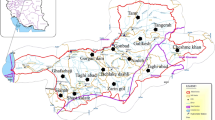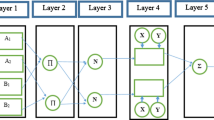Abstract
The present study focuses on quantitative (exact) and qualitative (classifying) drought forecasting in Gorganrood, Iran, based on monthly time-series of standard precipitation index (SPI) with 1–6 months lead-times. In so doing, recursive multi-layer perceptron (RMLP) and recursive support vector regression (RSVR) were optimized via an imperialist competitive algorithm (ICA). A traditional approach, autoregressive integrated moving average (ARIMA), has also been applied in this case. In quantitative forecasting, ICA-RMLP and ICA-RSVR models outperformed ARIMA ones according to three performance criteria namely, correlation coefficient (R), root mean square error (RMSE), and mean absolute error (MAE). For example, in SPI 24 and one month lead time forecasting; R, RMSE, and, MSE values for ARIMA model equaled to 0.90, 0.484, and 0.322 while, for ICA-RMLP equaled to 0.967, 0.277, and 0.188, respectively. In contrast, the criteria for ICA-RSVR were evaluated 0.969, 0.278, and 0.186, respectively. Increases in lead-times decreased the forecasting accuracy for both qualitative and quantitative forecasting. However, increases in SPI scales provided more accurate results. Whereas, in the quantitative forecasting, model could provide appropriate forecasts for all scales of SPI. According to the performance of the proposed framework, it would be practical for developing a drought warning system.







Similar content being viewed by others
References
Akaike H (1974) A new look at the statistical model identification. IEEE Trans Autom Control 19(6):716–723
Almedeij J (2016) Long-term periodic drought modeling. Stochastic Environ Res Risk Assess 30(3):901–910
Araghinejad S (2013) Data-driven modeling: using MATLAB® in water resources and environmental engineering. vol 67. Springer Science & Business Media, Berlin
Atashpaz-Gargari E, Lucas C (2007) Imperialist competitive algorithm: an algorithm for optimization inspired by imperialistic competition. In 2007 IEEE Congress on Evolutionary Computation, 4661–4667
Azarnivand A, Banihabib ME (2016) A multi-level strategic group decision making for understanding and analysis of sustainable watershed planning in response to environmental perplexities. Group Decis Negot. doi:10.1007/s10726-016-9484-8
Bacanli UG, Firat M, Dikbas F (2009) Adaptive neuro-fuzzy inference system for drought forecasting. Stoch Environ Res Risk Assess 23(8):1143–1154
Barua S, Ng AWM, Perera BJC (2012) Artificial neural network–based drought forecasting using a nonlinear aggregated drought index. J Hydrol Eng 17(12):1408–1413
Belayneh A, Adamowski J (2013) Drought forecasting using new machine learning methods/Prognozowanie suszy z wykorzystaniem automatycznych samouczących się metod. J Water Land Dev 18(9):3–12
Box GE, Jenkins GM, Reinsel GC, Ljung GM (2015) Time series analysis: forecasting and control. Wiley, Hoboken
Bozorg-Haddad O, Azarnivand A, Hosseini-Moghari SM, Loáiciga HA (2016a) Development of a comparative multiple criteria framework for ranking Pareto optimal solutions of a multiobjective reservoir operation problem. J Irrig Drain Eng 142(7):04016019
Bozorg-Haddad O, Azarnivand A, Hosseini-Moghari SM, Loáiciga HA (2016b) WASPAS application and evolutionary algorithm benchmarking in optimal reservoir optimization problems. J Water Resour Plann Manage 143(1):04016070
Cherkassky V, Ma Y (2004) Practical selection of SVM parameters and noise estimation for SVM regression. Neural Netw 17(1):113–126
Cheval S, Busuioc A, Dumitrescu A, Birsan MV (2014) Spatiotemporal variability of meteorological drought in Romania using the standardized precipitation index SPI. Clim Res 60(3):235–248
Chisadza B, Tumbare MJ, Nyabeze WR, Nhapi I (2015) Linkages between local knowledge drought forecasting indicators and scientific drought forecasting parameters in the Limpopo River Basin in Southern Africa. Int J Disaster Risk Reduct 12:226–233
Chitsaz N, Hosseini-Moghari SM (2017) Introduction of new datasets of drought indices based on multivariate methods in semi-arid regions. Hydrol Res. doi:10.2166/nh.2017.254
Chitsaz N, Azarnivand A, Araghinejad S (2016) Pre-processing of data-driven river flow forecasting models by singular value decomposition (SVD) technique. Hydrol Sci J 61(12):2164–2178
Dastorani MT, Afkhami H (2011) Application of artificial neural networks on drought prediction in Yazd (Central Iran). Desert 16(1):39–48
Durdu ÖF (2010) Application of linear stochastic models for drought forecasting in the Büyük Menderes river basin, western Turkey. Stoch Environ Res Risk Assess 24(8):1145–1162
Edwards DC (1997) Characteristics of 20th century drought in the United States at multiple time scales (No. afit-97-051). Air force inst of tech wright-patterson afb oh
Eslamian S (ed) (2014) Handbook of engineering hydrology: modeling, climate change, and variability. CRC Press, Boca Raton
Gorgij AD, Kisi O, Moghaddam AA (2016) Groundwater budget forecasting, using hybrid wavelet-ANN-GP modelling: a case study of Azarshahr Plain, East Azerbaijan, Iran. Hydrol Res. doi:10.2166/nh.2016.202
Guttman NB (1999) Accepting the Standardized Precipitation Index: a calculation algorithm. J Am Water Resour Assoc 35(2):311–322
Hornik K, Stinchcombe M, White H (1989) Multilayer feedforward networks are universal approximators. Neural Netw 2(5):359–366
Javan K, Lialestani MRFH, Nejadhossein M (2015) A comparison of ANN and HSPF models for runoff simulation in Gharehsoo River watershed, Iran. Model Earth Syst Environ 1(4):41
Jayanthi H, Husak GJ, Funk C, Magadzire T, Adoum A, Verdin JP (2014) A probabilistic approach to assess agricultural drought risk to maize in Southern Africa and millet in Western Sahel using satellite estimated rainfall. Int J Disaster Risk Reduct 10:490–502
Kan G, Yao C, Li Q, Li Z, Yu Z, Liu Z, Liang K (2015) Improving event-based rainfall-runoff simulation using an ensemble artificial neural network based hybrid data-driven model. Stoch Environ Res Risk Assess 29(5):1345–1370
Kisi O, Dailr AH, Cimen M, Shiri J (2012) Suspended sediment modeling using genetic programming and soft computing techniques. J Hydrol 450:48–58
McKee TB, Doesken NJ, Kleist J (1993) The relationship of drought frequency and duration to time scales. In: Proceedings of the 8th Conference on Applied Climatology, vol 17, no 22, American Meteorological Society, Boston, pp 179–183
Mishra AK, Desai VR (2005) Drought forecasting using stochastic models. Stochastic. Environ Res Risk Assess 19(5):326–339
Mishra AK, Desai VR (2006) Drought forecasting using feed-forward recursive neural network. Ecol Model 198(1):127–138
Mishra AK, Singh VP (2010) A review of drought concepts. J Hydrol 391(1):202–216
Mishra AK, Singh VP (2011) Drought modeling—A review. J Hydrol 403(1):157–175
Mishra AK, Desai VR, Singh VP (2007) Drought forecasting using a hybrid stochastic and neural network model. J Hydrol Eng 12(6):626–638
Modarres R (2007) Streamflow drought time series forecasting. Stoch Environ Res Risk Assess 21(3):223–233
Morid S, Smakhtin V, Bagherzadeh K (2007) Drought forecasting using artificial neural networks and time series of drought indices. Int J Climatol 27(15):2103–2111
Pandey PK, Nyori T, Pandey V (2017) Estimation of reference evapotranspiration using data driven techniques under limited data conditions. Model Earth Syst Environ 1–13
Pangapanga PI, Jumbe CB, Kanyanda S, Thangalimodzi L (2012) Unravelling strategic choices towards droughts and floods’ adaptation in Southern Malawi. Int J Disaster Risk Reduct 2:57–66
Partal T, Cigizoglu HK, Kahya E (2015) Daily precipitation predictions using three different wavelet neural network algorithms by meteorological data. Stoch Environ Res Risk Assess 29(5):1317–1329
Reed PM, Hadka D, Herman JD, Kasprzyk JR, Kollat JB (2013) Evolutionary multiobjective optimization in water resources: the past, present, and future. Adv Water Resour 51(1):438–456
Schwarz G (1978) Estimating the dimension of a model. Annal Stat 6(2):461–464
Shamshirband S, Amirmojahedi M, Gocić M, Akib S, Petković D, Piri J, Trajkovic S (2015) Estimation of reference evapotranspiration using neural networks and cuckoo search algorithm. J Irrig Drain Eng 142(2):04015044
Sharma N, Zakaullah M, Tiwari H, Kumar D (2015) Runoff and sediment yield modeling using ANN and support vector machines: a case study from Nepal watershed. Model Earth Syst Environ 1(3):23
Sudheer KP, Gosain AK, Ramasastri KS (2003) Estimating actual evapotranspiration from limited climatic data using neural computing technique. J Irrig Drain Eng 129(3):214–218
Taormina R, Chau KW (2015) Neural network river forecasting with multi-objective fully informed particle swarm optimization. J Hydroinformatics 17(1):99–113
Tay FE, Cao L 2001 Application of support vector machines in financial time series forecasting. Omega 29(4):309–317
Udmale PD, Ichikawa Y, Manandhar S, Ishidaira H, Kiem AS, Shaowei N, Panda SN (2015) How did the 2012 drought affect rural livelihoods in vulnerable areas? Empirical evidence from India. Int J Disaster Risk Reduct 13:454–469
Vapnik V (1995) The nature of statistical learning theory. Springer Verlag, New York
Wagh VM, Panaskar DB, Muley AA, Mukate SV, Lolage YP, Aamalawar ML (2016) Prediction of groundwater suitability for irrigation using artificial neural network model: a case study of Nanded tehsil, Maharashtra, India. Model Earth Syst Environ 2(4):196
Wilhite DA, Glantz MH (1985) Understanding: the drought phenomenon: the role of definitions. Water Int 10(3):111–120
Wilhite DA, Rosenberg NJ, Glantz MH (1986) Improving federal response to drought. J Climate Appl Meteorol 25(3):332–342
Wu CL, Chau KW, Li YS (2008) River stage prediction based on a distributed support vector regression. J Hydrol 358(1):96–111
Author information
Authors and Affiliations
Corresponding author
Rights and permissions
About this article
Cite this article
Hosseini-Moghari, SM., Araghinejad, S. & Azarnivand, A. Drought forecasting using data-driven methods and an evolutionary algorithm. Model. Earth Syst. Environ. 3, 1675–1689 (2017). https://doi.org/10.1007/s40808-017-0385-x
Received:
Accepted:
Published:
Issue Date:
DOI: https://doi.org/10.1007/s40808-017-0385-x




